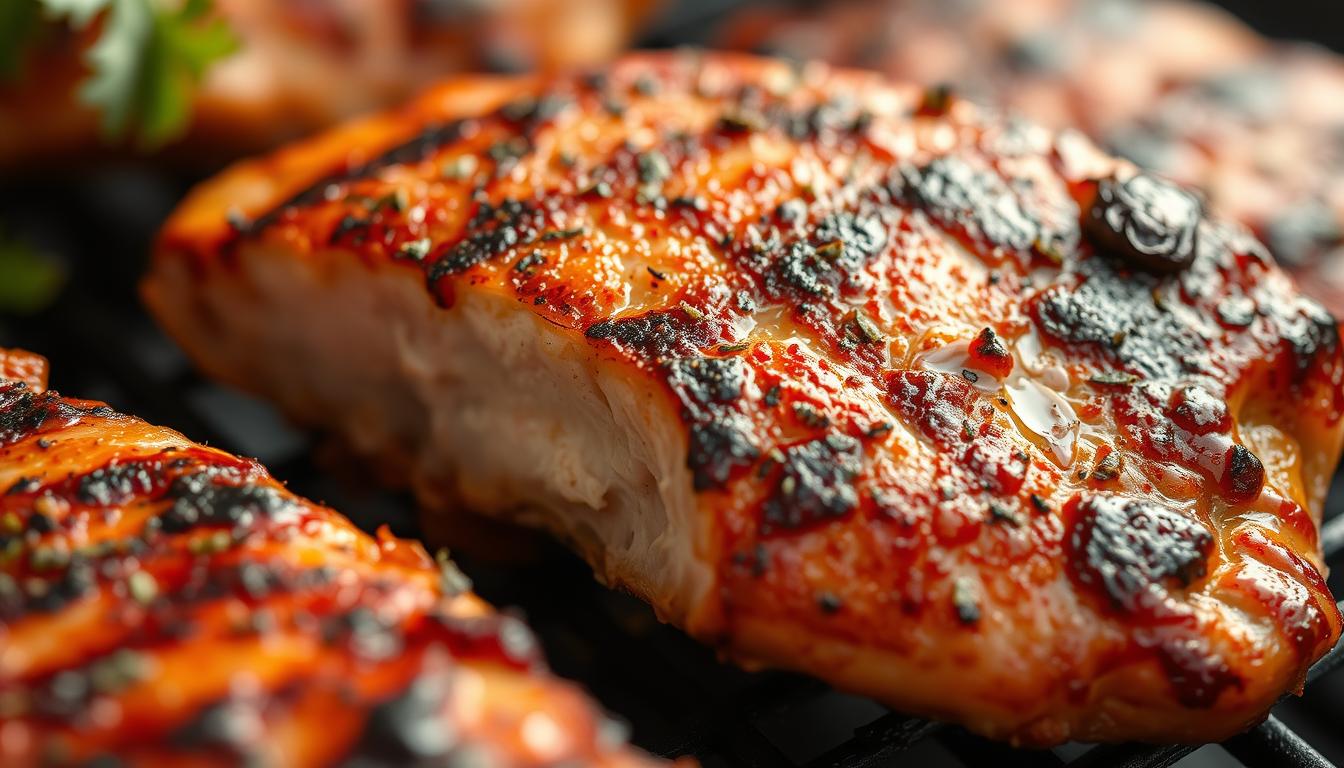Summer evenings remind me of my grandfather’s legendary backyard chicken griller. The sizzling sounds and the aroma of grilled chicken were magical. Every bite was a celebration of flavor and technique.
Mastering the chicken griller is more than cooking; it’s an art. It turns simple meals into unforgettable experiences. These seven tips will make your grilled chicken amazing, whether you’re a weekend cook or a serious chef.
Grilled chicken can be tricky. Often, it ends up dry and tasteless. But with the right techniques, you’ll make juicy, flavorful chicken that everyone will love.
In this guide, we’ll share the secrets to becoming a chicken griller master. You’ll learn how to pick the best cuts, make perfect marinades, control temperature, and get those beautiful grill marks. These will make everyone’s mouth water.
Get ready to improve your grilling skills and be the hero of your next backyard cookout. Your journey to making the most delicious grilled chicken starts here.
Understanding the Perfect Chicken Cuts for Grilling
Choosing the right chicken cuts is key for tasty griller recipes. Not all chicken parts are the same for grilling. Knowing which cuts are best can turn your backyard BBQ into a feast.
Your choice of chicken cut can make or break your grilling experience. Different chicken parts offer unique textures, flavors, and cooking styles. These can take your grilling to the next level.
Bone-in vs Boneless: A Flavorful Debate
Grilling chicken comes down to two main choices: bone-in and boneless cuts. Each has its own benefits:
- Bone-in Cuts: Keep more moisture and taste richer
- Boneless Cuts: Cook quicker and give more even results
Top Chicken Parts for Grilling
Some chicken parts are better for grilling:
- Chicken Thighs: Juicy and easy to cook
- Chicken Breasts: Lean and versatile
- Drumsticks: Tasty and affordable
Selecting Quality Chicken
Always pick high-quality chicken for your griller recipes. Look for fresh, firm meat without any color changes. Organic or free-range chickens usually taste better and feel softer.
Pro tip: Fresh, high-quality chicken is the foundation of any great grilling experience.
Understanding chicken selection is the first step to grilling success. By choosing the right cuts and quality, you’ll make delicious, memorable meals.
Essential Chicken Griller Equipment and Setup
Turning your backyard into a chicken griller paradise starts with the right gear. The right tools and grill setup are key for a great grilling experience. Whether you’re new or experienced, the right equipment makes grilling fun and easy.
Here are the essential tools for a great chicken griller experience:
- High-quality stainless steel grill tongs
- Digital meat thermometer
- Sturdy grill brush for cleaning
- Heavy-duty aluminum foil
- Cutting board dedicated to raw meat
Choosing the right grill is important for perfect chicken. Gas grills offer consistent heat, while charcoal grills give that smoky taste. Pro tip: Invest in a grill with multiple temperature zones for more versatile cooking.
| Grill Type | Temperature Control | Flavor Profile | Ease of Use |
|---|---|---|---|
| Gas Grill | Excellent | Mild | High |
| Charcoal Grill | Moderate | Smoky | Medium |
| Electric Grill | Good | Neutral | Very High |
Before you start grilling, prep your gear. Clean the grates well, apply oil to prevent sticking, and preheat to the right temperature. These steps will make you a confident chicken griller.
Mastering the Art of Chicken Marinade
Creating delicious chicken griller recipes starts with understanding marinades. A great marinade turns ordinary chicken into a flavorful meal. It will impress your family and friends. The right mix of ingredients can make your grilling better and ensure juicy results every time.
Marinades infuse chicken with amazing flavors and tenderize the meat. Your grilling skills will improve a lot when you master marinating.
Basic Marinade Ingredients
Every great marinade has three main parts:
- Acid: Lemon juice, vinegar, or wine to tenderize meat
- Oil: Olive oil or vegetable oil to spread flavors
- Seasonings: Herbs, spices, and aromatics for flavor depth
Marination Time Guidelines
| Chicken Cut | Minimum Time | Maximum Time |
|---|---|---|
| Boneless Chicken Breasts | 30 minutes | 2 hours |
| Bone-in Chicken Pieces | 2 hours | 8 hours |
| Whole Chicken | 4 hours | 12 hours |
Flavor Enhancement Techniques
To make your chicken griller recipes even better, try these tips:
- Use fresh herbs for maximum flavor impact
- Include a small amount of sugar to help with caramelization
- Always marinate in a non-reactive container
- Pat chicken dry before grilling to ensure perfect sear
Remember, patience is key when marinating. Give your chicken enough time to soak up those amazing flavors. You’ll create a meal that’s sure to impress.
Proper Temperature Control and Grilling Zones

Mastering temperature control is key for every top chicken griller. It’s important to know how to manage different heat zones. This can make your grilled chicken go from good to great.
It’s vital to have two grilling zones for perfect chicken. The hot zone is for searing and getting those nice crispy marks. The cooler zone is for finishing cooking without burning the chicken.
- Hot Zone: High direct heat for initial searing
- Cooler Zone: Lower indirect heat for gentle cooking
- Temperature Range: 375-450°F for optimal grilled chicken
To be a top chicken griller, use a two-zone grilling method. First, preheat your grill. Then, make sure there’s a clear difference between the hot and cool areas.
| Grilling Zone | Temperature | Purpose |
|---|---|---|
| Direct Heat Zone | 425-450°F | Searing and creating grill marks |
| Indirect Heat Zone | 325-375°F | Finishing cooking without burning |
Get a good meat thermometer to check your chicken’s internal temperature. Chicken is safe at 165°F. This ensures it’s both tasty and safe to eat.
Pro tip: Let your chicken rest for 5-10 minutes after grilling. This lets the juices spread, making it more tender and flavorful.
Secret Techniques for Juicy Grilled Chicken
To make a simple chicken griller into a delicious meal, you need more than basic cooking skills. Professional grillers use secrets to keep chicken tender, juicy, and full of flavor. Mastering these expert techniques will take your grilling to the next level.
Brining: The Moisture Magic
Brining is a key method for a tasty chicken griller. It involves soaking chicken in a saltwater solution to boost moisture and flavor. Here’s how to brine right:
- Create a basic brine with water, salt, and sugar
- Soak chicken for 1-2 hours before grilling
- Rinse chicken and pat dry before cooking
Moisture Retention Strategies
To keep chicken moist while grilling, use these strategies:
- Use indirect heat cooking methods
- Avoid overcooking by monitoring internal temperature
- Let chicken rest 5-10 minutes after grilling
Precision Temperature Monitoring
Accurate temperature control is key for pros. Use a digital meat thermometer to check your chicken’s internal temperature. Aim for 165°F to ensure safety and juiciness.
“The difference between good and great grilling is often just a few degrees.” – Grilling Expert
Ultimate Seasoning and Flavor Combinations

Improving your chicken griller recipes begins with mastering seasoning. The right mix of herbs, spices, and rubs can turn simple chicken into a flavorful delight. Whether you’re aiming for a healthy dish or bold flavors, seasoning is key.
Creating the perfect seasoning blend needs creativity and knowledge of flavors. Here are some top seasoning strategies to elevate your grilled chicken:
- Mediterranean-inspired herb blend with rosemary, thyme, and oregano
- Spicy Southwest rub featuring chili powder and smoked paprika
- Citrus-infused seasoning with lemon zest and fresh herbs
- Asian-inspired marinade with ginger, garlic, and soy sauce
To craft delicious and healthy chicken griller recipes, try these flavor-packed seasoning combinations:
| Flavor Profile | Key Ingredients | Health Benefits |
|---|---|---|
| Herb Garden | Basil, Parsley, Thyme | Low sodium, antioxidant-rich |
| Spicy Caribbean | Allspice, Cayenne, Garlic | Metabolism boosting |
| Lemon Pepper | Black Pepper, Lemon Zest | Aids digestion, vitamin C |
Pro tip: Always try fresh herbs and spices to keep your chicken griller recipes fresh and healthy. Remember, a little seasoning goes a long way. You want to enhance the chicken’s natural taste, not hide it.
The key to great grilled chicken is balancing flavors while keeping the dish healthy and delicious.
Expert Tips for Even Cooking and Perfect Grill Marks
Grilling chicken perfectly is more than just throwing meat on a hot grate. To be a top chicken griller, you need to know how to cook evenly and get those great grill marks. It’s all about understanding how heat works with your chicken and using smart grilling methods.
To become an easy chicken griller, start by learning how to control your grill’s heat and surface. Professional grillers have secrets to turn simple chicken into a dish fit for a restaurant.
Two-Zone Grilling Approach
The two-zone grilling method is a big help for cooking chicken evenly. Here’s how to set it up:
- Create a hot direct heat zone for searing
- Establish a cooler indirect heat zone for slower cooking
- Move chicken between zones to control doneness
“Perfect grilling is about controlling heat, not just applying it.” – Grilling Experts
Mastering Timing and Flipping
Flipping chicken right is key to great grilling. Here are some tips from the pros:
- Use tongs to flip chicken gently
- Flip only once every 4-5 minutes
- Rotate 45 degrees for those classic crosshatch grill marks
- Avoid pressing down on chicken, which releases precious juices
By following these tips, you’ll get better at grilling. You’ll make chicken that’s evenly cooked and looks amazing. It will impress everyone at your next gathering.
BBQ Sauce Application and Glazing Methods
Learning how to apply BBQ sauce can make your grilled chicken amazing. Timing is key to get flavor and caramelization right.
Perfect glazing comes from knowing when and how to use BBQ sauce. Grill masters avoid burning and soak up flavors by applying sauce carefully.
- Apply BBQ sauce during the last 3-5 minutes of grilling
- Use a silicone brush for even sauce distribution
- Create multiple thin layers instead of one thick coating
- Keep grill temperature moderate to prevent sauce burning
Each type of grilled chicken needs its own glazing method. Bone-in cuts need more careful sauce application than boneless ones.
| Chicken Cut | Sauce Application Technique | Recommended Cooking Time |
|---|---|---|
| Chicken Breasts | Light, even brushing | 4-5 minutes per side |
| Chicken Thighs | Multiple thin layers | 6-7 minutes per side |
| Chicken Wings | Toss in sauce after grilling | 8-10 minutes total |
When working with your delicious chicken griller, remember that patience is crucial. Let the sauce caramelize without burning. This creates a perfect glaze that keeps moisture in and boosts flavor.
Conclusion
Mastering grilling chicken is a journey of flavor, technique, and passion. Your chicken griller can turn simple meals into amazing dishes. By following the strategies we’ve shared, you’ll create healthy, tasty chicken recipes that wow everyone.
Practice is key to becoming a grill master. Try new marinades, seasonings, and techniques. Each time you grill, you’ll get better and more confident. Great grilling is about knowing your gear, respecting your ingredients, and finding your own style.
Healthy chicken grilling opens up a world of flavors and fun. By using the tips from this guide, you’ll make delicious, nutritious meals. Every dish will get better, and you’ll love the process more and more.
Your chicken griller is more than a tool—it’s a way to explore and enjoy food. Keep trying new things, learning, and grilling. It’s all about the journey and the joy of cooking.

